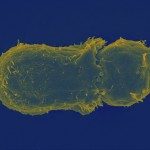Lien vers Pubmed [PMID] – 15059847
Blood 2004 Aug;104(3):760-7
Engagement of the T-cell receptor (TCR) results in the activation of Lck/Fyn and ZAP-70/Syk tyrosine kinases. Lck-mediated tyrosine phosphorylation of signaling motifs (ITAMs) in the CD3-zeta subunits of the TCR is an initial step in the transduction of signaling cascades. However, zeta phosphorylation is also promoted by ZAP-70, as TCR-induced zeta phosphorylation is defective in ZAP-70-deficient T cells. We show that this defect is corrected by stable expression of ZAP-70, but not Syk, in primary and transformed T cells. Indeed, these proteins are differentially coupled to the TCR with a 5- to 10-fold higher association of ZAP-70 with zeta as compared to Syk. Low-level Syk-zeta binding is associated with significantly less Lck coupled to the TCR. Moreover, diminished coupling of Lck to zeta correlates with a poor phosphorylation of the positive regulatory tyr352 residue of Syk. Thus, recruitment of Lck into the TCR complex with subsequent zeta chain phosphorylation is promoted by ZAP-70 but not Syk. Importantly, the presence of ZAP-70 positively regulates the TCR-induced tyrosine phosphorylation of Syk. The interplay between Syk and ZAP-70 in thymocytes, certain T cells, and B-chronic lymphocytic leukemia cells, in which they are coexpressed, will therefore modulate the amplitude of antigen-mediated receptor signaling.


